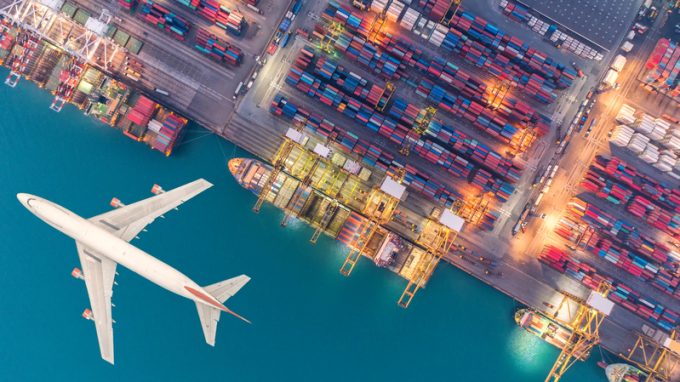A new trade war with US would threaten China’s 'historic' airfreight boom
China’s civil aviation authority may be talking-up its “historic highs” in airfreight volumes over the ...
FDX: ABOUT USPS PRIVATISATIONFDX: CCO VIEWFDX: LOWER GUIDANCE FDX: DISRUPTING AIR FREIGHTFDX: FOCUS ON KEY VERTICALFDX: LTL OUTLOOKGXO: NEW LOW LINE: NEW LOW FDX: INDUSTRIAL WOESFDX: HEALTH CHECKFDX: TRADING UPDATEWMT: GREEN WOESFDX: FREIGHT BREAK-UPFDX: WAITING FOR THE SPINHON: BREAK-UP ALLUREDSV: BREACHING SUPPORTVW: BOLT-ON DEALAMZN: TOP PICK
FDX: ABOUT USPS PRIVATISATIONFDX: CCO VIEWFDX: LOWER GUIDANCE FDX: DISRUPTING AIR FREIGHTFDX: FOCUS ON KEY VERTICALFDX: LTL OUTLOOKGXO: NEW LOW LINE: NEW LOW FDX: INDUSTRIAL WOESFDX: HEALTH CHECKFDX: TRADING UPDATEWMT: GREEN WOESFDX: FREIGHT BREAK-UPFDX: WAITING FOR THE SPINHON: BREAK-UP ALLUREDSV: BREACHING SUPPORTVW: BOLT-ON DEALAMZN: TOP PICK

Air and ocean capacity from Asia to major markets is going to remain tight, driving up rates as a convergence of factors is increasing demand.
More business is shifting to spot pricing and some traffic will migrate from ocean to airfreight, Dimerco predicts in its latest Asia Pacific Freight report for May.
The global manufacturing PMI retreated in April, but remained in expansion territory for a third consecutive month. The reading of 50.3 indicates global GDP growth of 2.7%, say the report’s authors.
Moderate economic expansion has been one driver of exports from Asia, but volumes have been boosted by disruptive developments, ranging from the spectre of work stoppages in Canada and on the US east coast to looming new tariffs in the US and Brazil, and regulations like the EU’s Import Control System 2 that have prompted Asian exporters to step up their shipping.
US tariffs, especially those for electronic vehicles, have caused a surge in advance bookings from China, while Brazil’s plans to levy taxes on Chinese hybrid and electronic vehicles have been a driver of quadrupling FCL rates from China to Latin America’s largest economy, the report points out.
As a result, there has been no slow season since March, and rates have remained high.
The situation has been aggravated by significant capacity reductions in the seafreight sector. The authors point to 44 cancellations in east-west headhaul from weeks 21 to 25 (a cancellation rate of 7%), of which 50% are affecting the transpacific eastbound and 27% the Asia-Europe westbound sectors (with the remaining 23% hitting the transatlantic market).
In the first four months, seafreight volumes to North America were up 19.1%, but capacity fell back 14% to the US west coast and 11% to the east coast.
According to Alvin Fuh, special assistant to the CEO of Dimerco Express Group, the situation in the Red Sea has a knock-on effect on intra-Asia traffic. It has caused congestion and wait times for berth space from two to six days in Singapore. This has prompted some carriers to re-direct sone longhaul loops to other gateways, like Port Klang.
Listen to this clip from The Loadstar Podcast to hear how DP World is cutting emissions via expansion of its Modal Shift Programme:
For the Asia-to-US sector, Dimerco predicts tight seafreight capacity to the US east and Gulf coasts and to Canada, and backlogs to the US west coast. Pricing is rising across the board. To Europe, space is going to be tight, with pricing heading up.
From Taiwan, seafreight bookings to Europe and North America have to be made a month in advance, Dimerco points out.
And Airfreight capacity to the US is expected to be tight out of Taiwan, Korea, India, Malaysia and Thailand, while Dimerco anticipates backlogs out of Singapore and the two Vietnamese gateways.
Pricing here too is expected to rise, except in south-east, central and east China, India and the Philippines.
To Europe, the report predicts backlogs in Singapore and tight airfreight capacity out of China, Korea, Taiwan, Indonesia, Malaysia, Thailand and Vietnam. Rates are likely to rise everywhere, except south-east, central and east China, India and the Philippines.
In the wake of the sharp increase in transpacific ocean rates, allocations to NVOs have sunk. Their share of volume fell from 49.7% last year to 43.7% in April. At the same time, the carriers have reduced fixed-rate space allocations.
This tight situation on the water is fuelling rising interest in airfreight, said Dimerco Express Group VP Kathy Liu.
“It is anticipated that more less-than-containerload shipments will switch to airfreight from this month, especially on the TPEB route, resembling the situation in 2021,” she explained.
“Furthermore, with the new tariff set to be implemented in August, it is expected that a surge in products related to this tariff will occupy both air and ocean capacity to meet the expected arrival dates before it takes effect.”
Comment on this article